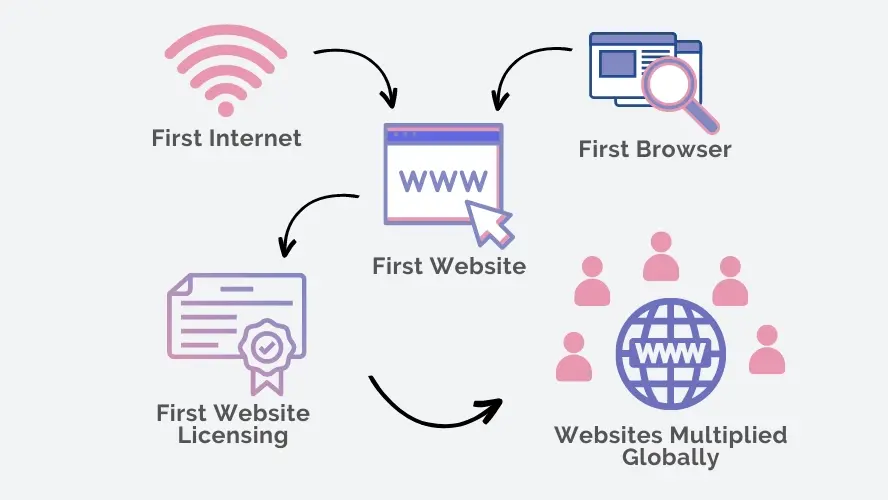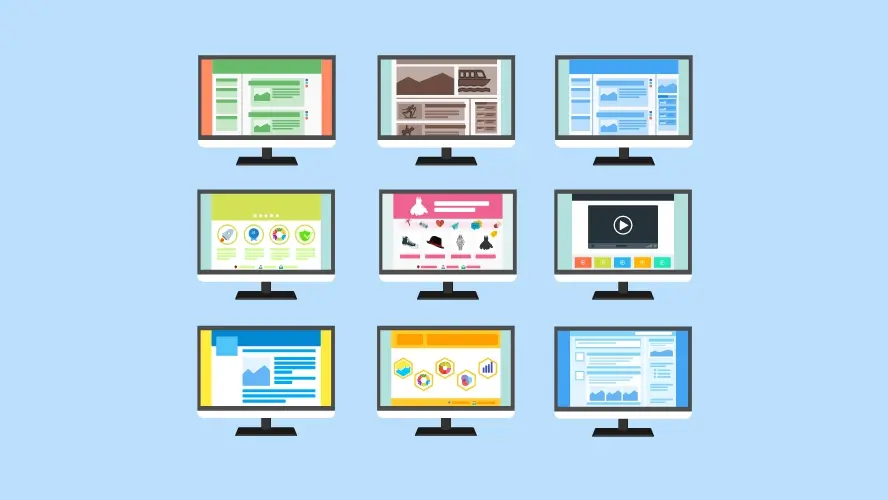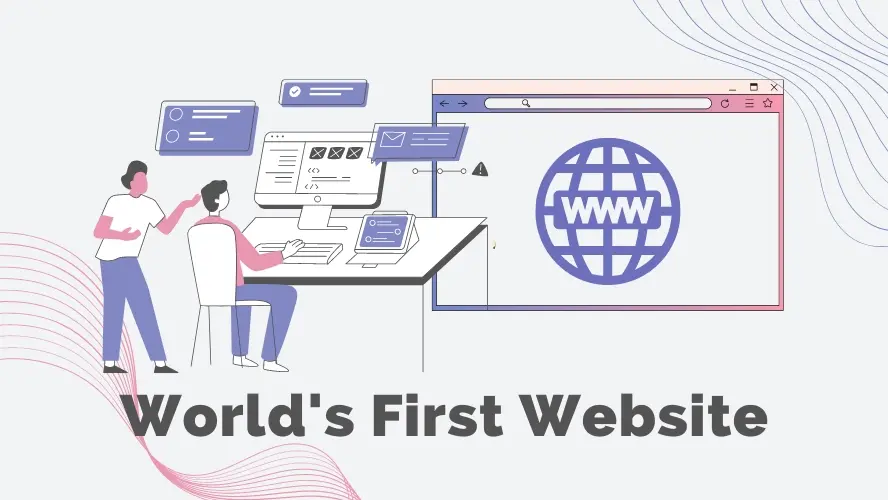Almost everyone can access a website easily using a web browser. A user just needs to enter the URL to the browser’s address bar, then the browser will load a web page in a second. But have you ever thought of how this technology was invented? What was the world’s first website look like?
It will be interesting to understand how the world wide web has evolved into what we see today as billions of people depend on it to find information from around the globe within a few clicks. So in this article, you will learn the history of the world’s first website and how it was created.
The Brief History of the World’s First Website
While working at CERN (European Organization for Nuclear Research) in 1989, British scientist Tim Berners-Lee developed the World Wide Web (WWW). It was his big concern about the need for automated sharing of information among scientists in universities and institutes worldwide that became the main motive of the first website development.
At the CERN laboratory in Geneva, Berners-Lee presented the managers with the concept of an information management system in 1990. In order to link material of information on different computers connected to the Internet, the system would employ hypertext to do so.
Berners-Lee thought of a simple idea of easy information sharing, as the Internet already existed at that point in time. However, another concern is rising as there was no website, or no other methods for any computer anywhere in the world to view the same information accurately, fast, and simultaneously. The final piece of the puzzle, which Berners-Lee contributed, is this: “Click it to go to a different website page.”
How the World’s First Website Was Created
Supporting Technology of The First Website
Before the internet was invented, there was no common method for connecting the many computer networks. Transfer Control Protocol/Internetwork Protocol (TCP/IP) is a brand-new communication protocol. This made it possible for various computer types connected to various networks to "communicate" with one another.
On January 1, 1983, TCP/IP became the official protocol for ARPANET and the Defense Data Network, resulting in the creation of the Internet. A universal language could now link all networks with the adoption of Kahn and Vinton's communications architecture for the ARPANET led to the creation of the modern internet.
In 1991, Berners-Lee presented a revised proposal to his managers as he created a HTML page, HTTP, and URLs which became the building blocks for developing websites. The World Wide Web was therefore created on August 6, 1991, with the development of a single web page. The term "World Wide Web" is also frequently misinterpreted to refer to the Internet. In fact, it is just a method of accessing the internet from websites.
The World Wide Web Project was actually the content on the first webpage ever made which enables users to link or connect to other web pages using hypertext. It is made accessible as Berners-Lee convinced his managers to allow the first website to run for free. Therefore, everyone could learn about hypertext which consists of code words or phrases that link to content, and how to make web pages from it.
The first web server outside of Europe was set up on December 12th, 1991, at the Stanford Linear Accelerator Center (SLAC) in California. It gave users access to SPIRES, a database that contains data for researchers working in high-energy physics and allows them to look for papers. By the end of 1994, there were more than 10,000 web servers worldwide, and 2000 were commercial.
The First Website Browser
Tim Berners-Lee developed WorldWideWeb, which was the very first web browser, in 1990. However excellent the WorldWideWeb was, it was only compatible with the NeXT operating system. Ideally, a website should be easy to access and usable on a variety of computers, not only NeXT ones. The research and experiment were ongoing to overcome the situation.
That’s when the line-mode browser was helpful in this situation. It was the first web browser launched in 1992 to include a cross-platform codebase, enabling installation on a variety of computer types. The line-mode browser’s interface was simple and pretty straightforward yet the role was also crucial in showcasing the potential of the web in its early years.
The First Website Licensing
CERN released the code for the World Wide Web to the public on April 30, 1993. The release is available under an open web license soon after, which was a more reliable strategy for maximizing its reach and open collaboration for the benefit of society. Apparently, the web was made accessible by these steps, inviting more people to get involved with this new technology.
The number of websites multiplied from the year 1992 to the year 1994 when the W3 became the public domain. By the time the search engine Google made a start in 1996, there were 2 million websites. According to the International Telecommunications Union, 66% of the world’s population, or more than 5 billion people, frequently use the Internet for study, business, communications, and entertainment. It has become an essential part of our everyday lives.

The World Wide Web Rebuild
This very first website URL, http://info.cern.ch, was restored when CERN started a project in 2013. The initial goal of the project was to restore the original URL The site path that can tell the history of the first website ever built, for the benefit of future generations.
Besides adding the files that were there in the first versions, the next stage of the project is to examine the initial CERN web servers to determine what materials to share and preserve from them. Another step to include is to take a closer look over the documentation and make an effort to change back machine names and IP addresses to their original.
The World Wide Web Today & Future
Back in the day, the line-mode browser can only display text. There’s no way you can click on links as you had to type in everything using a keyboard just to follow a link. The fast-growing number of websites these days is not only because of the open-source of the WorldWideWeb code but also because of the rapid development technology of the web browser.
Modern web browsers are much more powerful with many features and advantages to compare to one another. Browser compatibility becomes the main standard in web design and development. It helps to determine if a website or online web app works as intended in a specific browser version across several platforms or devices.
Not only growing in number, but the types of websites are also numerous. ECommerce websites have been a great platform to sell goods or services. Online learning, social media, and directory websites are other website-type examples widely known among Internet users. Websites can also be accessed as specific applications to increase productivity or grow your business.

Thirty years have passed since the first idea proposed would one day become the World Wide Web, Sir Tim Berners-Lee wrote a message to the world concerning current web problems for the 29th anniversary of WWW, which was published in March 2018.
The web’s future should close the digital divide so that everyone in the world can have access to affordable internet was one of Berners-Lee’s messages. His next message is to make the web work for people to avoid fake social media accounts and other prevent violations using the web technology. The last part of his message was to bring more voices to the debate on the web’s future to reflect hopes and fulfill everyone’s dreams, rather than magnify fears and deepen divisions.
Conclusion
The rapid change and demand in the technology industry are happening due to breakthroughs in artificial intelligence, quantum computing, machine learning apps, the Internet of Things (IoT), and many more. Each of them even comes down to how they interact with the websites with specific impacts to determine the future of website development.
Looking back to the last 3 decades to how the first website evolved into the modern website today, there are many aspects of web technology that have been involved and share the growth of success. The web browser, web visual media, web server, and security, are just a few of the web technology to mention here.
The spirit of open-source spirit is also one of the important aspects that boost web technology today. Since the beginning of the birth of a website, it is understood that open-source is a philosophy or methodology that promotes free redistribution and access to a product or ideas. David Howell wrote an article that open-source technology is about collaboration and community, as you’re entering a rich innovative environment that your business could play an active role in it.
Frequently Asked Questions
Why should I create a website?
There are many reasons why you should create a website if you’re an artist. You can use it to create a place where people can learn about you, talk about your art, or show off your work.
Is a website on WordPress safe?
Websites on WordPress are safe, however to avoid hacking keep your website up to date.
How is the website maintenance carried out?
On a daily basis, software, hardware, vulnerability, MariaDB, CloudLinux paths and cPanel updates are carried out on our servers without a reboot. However, if we have to carry out any maintenance that includes some downtime, we schedule in advance and update our status page
What is the best way to display my art on my website?
Your website can be used for many things; however, you need to keep in mind that you created your website to promote your art. Don’t get wrapped up in all the things around your site and forget to put the primary focus on your art.

Audee Mirza is a graphic designer and WordPress developer at audeemirza.com who resides in Surabaya, Indonesia. She's also the author of Graphic Identity Blog, a professional logo designer, and often creates vector illustrations for clients and marketplaces. She enjoys good typography design and all kinds of animation.
View all posts by Audee Mirza





















